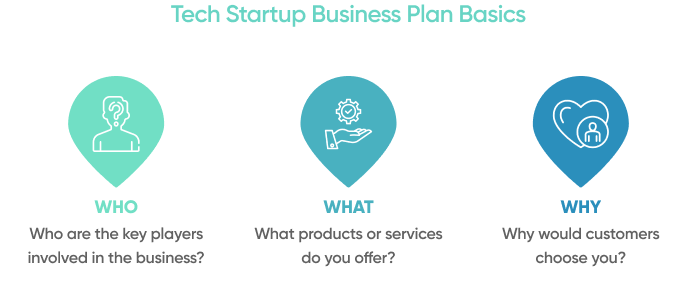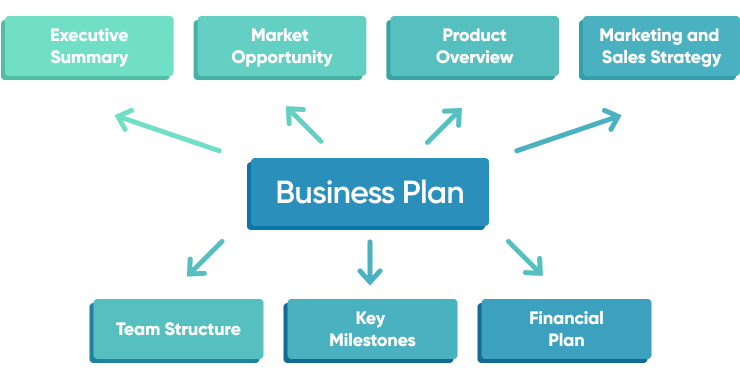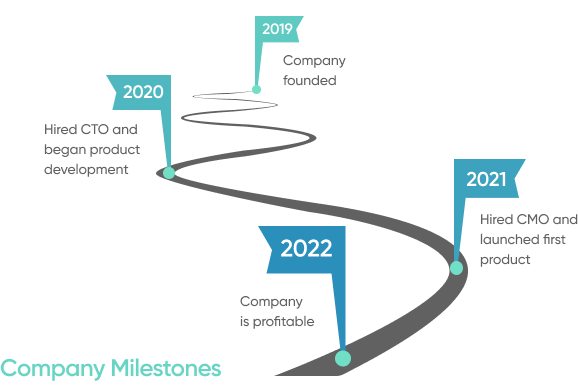You have a great business idea. Now you’re doing the hard part: raising capital.
With a failure rate of 63% in the tech startup industry, you need to have a highly compelling business idea and go-to-market strategy to win over investors.
We’re going to make writing a startup business plan really simple by providing you with a step-by-step guide along with a business plan template you can use to build startup business plan that wins investors.
What is a tech startup business plan?
A technology startup business plan is a document that is used to outline the goals, strategies, and objectives of a new tech startup business. This document is often used to secure funding from investors and to help the business leaders form a unified sense of identity and purpose.
The business plan should include information on the products or services offered by the startup, the market opportunity, the business model, the team, the financial projections, and the risks and challenges associated with the business. A tech startup’s business plan should generally address three major areas of the business:

As a startup moves through various stages of growth, the business plan should be updated with new information and forward-looking goals. In this way it can serve as a “source of truth” for all of the startup’s stakeholders.
Why do you need a technology startup business plan?
A business plan is an essential tool for any tech startup. It provides a road map for your business, helping you to define and communicate the company’s vision, goals, and strategies. Having a singular document that acts as a single source of truth for the business will help to keep the startup’s core leadership team unified and provides guidance on how to navigate the often-complex world of starting and growing a business.
You can utilize your startup business plan to secure funding and partnerships. A well-crafted business plan can also help you attract and retain top talent.
In summary, you need a technology startup business plan to:
- Unify the startup’s leadership team
- Secure funding and partnerships
- Attract top talent
- Act as a guide for navigating starting a business
This article will act as a guide for writing a business plan for tech startup founders.
7 key components of tech startup business plan
You know you need a business plan for your tech startup. You know generally what should be included. But, now you need to actually get to writing. We’re going to try to make this as easy as possible by outlining the 7 key components your technology startup business plan should have.
If you’re looking for a real shortcut, make sure you download our easy tech startup business plan template. Included in it you’ll find a sample business plan and an outline of what we’ll cover below.
Stick with me if you’re looking for a more detailed explanation of each of the 7 components.

Executive summary
First up is an executive summary. This brief section should provide some context to readers as they begin to read your business plan. It’s your opportunity to share, at a high level, your business idea.
At a minimum, this section should outline what your business is, the general market you target or industry you are in, and what your products or services are. Optionally, you can include some information about your business’s history, bios of key members of your leadership team, competitive advantages, key customer benefits, and your company’s goals. How detailed you get with this section is up to you. Use this as an opportunity to provide an overview before you get into more detail in the other sections of your business plan.
Market opportunity
This is where you will start to go into more detail about your business. Starting with the market opportunity allows you to paint the picture of the why _behind your tech startup before you go into the _what. Ultimately, you can only sell the feasibility of your business by backing it up data on who your potential customers will be. This section will help to inform the marketing strategy and sales plan later in the startup business plan document.
Take the time in this section to walk through the research you have done on your audience. To start, you should have data points on the following:
- Demographic data for your target market (age, gender, income, occupation, location)
- Main pain points of your target market
- Values and interests of your target market
- Needs and wants of your target market

It can also be compelling to provide some information on how your products or services will stand out from the competition. Consider answering the following questions in this section:
- Who are your main competitors?
- How will your products or services meet the market’s needs better than the competitors?
- Will your products or services be able to reach a currently unreached audience?
- How will you differentiate yourself from the competition within your target market?
All of this data should back up what the real market opportunity is for your business. Make sure this market opportunity is realistic and achievable. This should lead well into our next section which will cover in more detail the products or services your tech startup will offer to the market.
Product or service overview
After you have outlined the market opportunity your business will take advantage of, it’s time to provide more details on the exact products or services that you will offer to your market.
Each product or service you include in this section should have a corresponding functional and technical description. The functional description should aim to outline to a layperson what the product or service is, what it does, and how it will be used. The technical description should outline the technologies each product or service utilizes or what technology has been developed specifically for the new business. It’s appropriate to go into detail here to give potential investors more confidence in your product or service.
It’s also important to include information on how the products or services will ultimately benefit customers and what problem they will solve for customers. If you have more than one product or service, make sure to outline this information for each one.
Marketing and sales strategy
The marketing and sales strategy section of a technology startup business plan should include a description of the target market, the company's marketing and sales objectives, the strategies and tactics that will be used to reach these objectives, the key marketing and sales metrics that will be used to measure progress, and the budget for marketing and sales activities. In short, it should outline your business’s marketing and sales plan.

Starting with the objectives, you should outline specifically what you are trying to achieve with your marketing and sales efforts both in the short term (likely for launch) and long term. Each of your objectives should align with your overarching business goals and make sense for the market you outlined earlier in your business plan. Be realistic here. It’s better to estimate low and over deliver than to overestimate your success.
As you outline the strategies and tactics you will use to achieve your objectives, consider both the what _and the who_:
- (What) What tactics will you employ to achieve your goals?
- (What) What marketing tools do you need to achieve your goals?
- (What) What marketing channels will you use?
- (Who) Will the marketing work be done internally?
- (Who) Will you hire freelancers or a CMO to help implement the work at hand?
- (Who) Will you need a sales team right away?
- (Who) How will marketing and sales work together to achieve your goals?
Your marketing and sales strategy should be backed up by the market opportunity information you provided earlier. The strategies and tactics should be aiming to reach your target market.
Next, outline the metrics that will be used to measure marketing and sales progress. You should include specifically when these metrics will be measured and who will be held accountable for them.
Finally, include a marketing and sales budget in this section. The budget should be broken down by channel and tactic, so that dollars can be accurately tracked and attributed to results.
Team and management structure
Up next is the team and management structure part of the business plan. To start, provide an overview of the startup’s organizational and management structure. Providing a graphical representation of the reporting structure can be helpful.
This can then lead into an overview of who owns or manages each of the key sectors of the business (CEO, CTO, CMO, etc.). It’s a good practice to provide a bio of each of the members of the leadership team, including their education, work history, and relevant expertise. Along with their bio, provide a description of their role and responsibilities within the organization.

After you have covered the leadership team, outline the other team members along with their roles and responsibilities. Following this, include some commentary on the team’s strengths and weaknesses as well as what gaps remain within the organization. If additional staffing is required, provide a hiring plan that includes a description of the role, salary, and strategy for recruitment.
End this section with an overview of the organization’s values. Paint a picture of what it’s really like to work for your company and how you build a sense of ownership and responsibility within the team. Highlight how you intend for the team to work together to accomplish the company’s goals.
Key milestones
At this point in the business plan you have outlined the target market, products and services you will offer as well as the members of your team that will bring the company’s vision to life. In this section you’ll provide a timeline of the past and future milestones for your business. This will help to illustrate your startup’s growth path and how you intend to move forward.
Some key milestones to consider when writing this section:
- When business was founded.
- When the business was/will be launched publicly.
- When the business was/will be profitable.
- When the business reached/will reach funding milestones.
- When development project milestones were/will be reached.
- When marketing milestones were/will be reached.
- When key staff were/will be hired.
- Future product release dates.
You might consider showcasing this information in the form of a graphic like this:

In addition to a company timeline, we recommend you include additional data in this section such as:
- Current number of employees and the number of employees projected in the future.
- The amount of revenue generated in the past and projected for the future
- Key clients or contracts that have been signed or that are in the works.
This section should clearly demonstrate your startup’s ability to grow from an idea into a business. Providing concrete dates and real data in this section will provide some validity to your startup and showcase what you’re able to accomplish.
Financial plan
The final section of your technology startup business plan should be a financial plan. This is the section of the business plan that outlines how the business has been funded to date and how it will be financed moving forward.
There is no one way to write the financial plan section of a business plan, as the amount and type of information that needs to be included will vary depending on the business and the specific financial goals of the plan.
However, there are some basic elements that should be included in most financial plans. These include a pro forma income statement, balance sheet, sales forecast, and cash flow statement. The pro forma financial statements should be based on historical financial data, if available, and should include assumptions about future revenue and expenses. The financial plan should also include a discussion of the company's capital structure, including its debt and equity financing.
If you’re at a very early stage with your startup and seeking a modest amount of funding, it’s probably sufficient to air on the side of brevity. If you’re seeking series A, B, or C funding, you’ll likely need a very comprehensive financial summary along with a detailed plan on how the funding will be utilized to grow the business. Seek counsel from a business accountant if you’re unsure of how to provide adequate financial documentation.
Sample tech startup business plan [template]
We have walked through the 7 key elements of any tech startup business plan. Now we’re going to share a sample business plan template to help you get started with writing your own!
Innovation is critical to success in the software industry. The executive team of this startup believes they have the next big thing. They have developed a new software application that helps businesses manage their social media accounts more effectively. The software provides insights on when to post, what to post, and how to engage with customers. The software also allows businesses to track their social media analytics and see the return on investment for their social media campaigns.
The executive team has extensive experience in the software industry and believes this new product has the potential to be a game-changer for businesses. The team is seeking $1 million in seed funding to help with product development, marketing, and sales. The company plans to generate revenue through monthly subscription fees and by selling data analytics services to businesses.
Market opportunityThe social media management software market is expected to grow from $9.3 billion in 2020 to $17.4 billion by 2025, at a compound annual growth rate (CAGR) of 13.2%. This growth is being driven by the increasing use of social media by businesses of all sizes and the need to effectively manage social media accounts to drive brand awareness and customer engagement.
Product or service overviewThe software application developed by the startup helps businesses manage their social media accounts more effectively. The software provides insights on when to post, what to post, and how to engage with customers. The software also allows businesses to track their social media analytics and see the return on investment for their social media campaigns.
The software is available on a monthly subscription basis and businesses can also purchase data analytics services to help them further understand their social media campaigns.
Marketing and sales strategyThe company plans to generate awareness for the software through online and offline marketing campaigns. The team will target small businesses and medium businesses that are active on social media but do not have the resources to effectively manage their accounts.
The company will use a mix of paid and organic marketing to reach its target audience. For paid marketing, the company will use Google AdWords and Facebook Ads. For organic marketing, the company will use content marketing and social media outreach.
The company plans to sell the software on a monthly subscription basis. The team will offer a free trial to businesses to get them started with the software. Once the free trial expires, businesses will be charged a monthly subscription fee.
Team and management structureThe executive team of the startup consists of experienced software professionals. The team has a proven track record of developing and marketing successful software products.
The company plans to hire a sales and marketing team to help generate awareness and drive sales of the software. The team will be based in the United States and will consist of sales and marketing professionals with experience in the software industry.
Key milestonesThe company plans to achieve the following milestones over the next 12 months:
- Launch the software application
- Generate 500 paying customers
- Achieve $1 million in annual revenue
The company is seeking $1 million in seed funding to help with product development, marketing, and sales. The company plans to generate revenue through monthly subscription fees and by selling data analytics services to businesses.
The company projects the following financials for the next 12 months:
- Revenue: $1 million
- Expenses: $500,000
- Profit: $500,000
Conclusion
As a startup founder you know that having a software startup business plan on hand is critical to win over investors and get your business funded. However, no one wants to spend days writing a complicated it startup business plan. It’s much more important to focus on the day-to-day operation associated with building your tech startup.
To help save you time (but still create a winning startup business plan), we’ve outlined the 7 key components of any tech startup business plan:
- Executive summary
- Market opportunity
- Product or service overview
- Marketing and sales strategy
- Team and management structure
- Key milestones
- Financial plan
As you tackle writing your own, make sure you refer back to this guide along with our template to ensure you’re writing a compelling business plan that is sure to win over investors!







